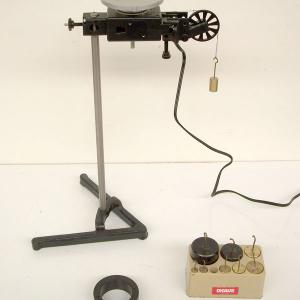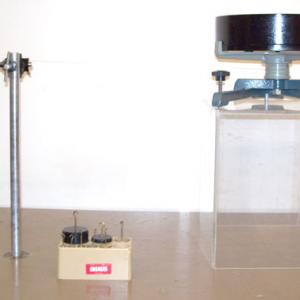College of Liberal Arts & Sciences
1Q20.20 - Moments of Inertia - Angular Acceleration Wheel
Place the disk on the shaft of the rotational support. As the masses are allowed to fall the rotational inertia of the disk can be calculated. The ring can be added to the top of the disk which adds more mass and therefore changes the value of the rotational inertia.
The smaller apparatus is designed to fit on a PASCO or Vernier rotary motion sensor and then the data is collected with the appropriate interface.
For a larger demonstration use the Cenco Apparatus set up as in Picture 3. A stop watch or a photogate may be used to collect the data. The disk and the ring in this apparatus have approximately the same mass ( about 4.7 kg ).
- J. Bierman, D. Buckley, J. Kemper, A. Greer, "A Rotational Dynamics Laboratory Upgrade", TPT, Vol. 59, #4, April 2021, p. 250.
- Asif Shakur, Taylor Sinatra, "Angular Momentum", TPT, Vol. 51, # 9, Dec. 2013, p. 564.
- Juan F. Carrau, et al., "The Anharmonic Rotating Wheel", TPT, Vol. 43, # 6, p. 349, Sept. 2005.
- Louie A. Galloway, III, "Angular Acceleration Measurements with the PASCO ME-9279", TPT, Vol. 30, # 3, Mar. 1992, p. 182.
- Fred Otto, "Unlocking the Confusion World of Rotation", TPT, Vol. 26, # 6, Sept. 1988, p. 382.
- Eric R. Dietz, "One Good Turn: Emphasizing the Importance of the Origin for the Discussion of Angular Momentum", TPT, Vol. 24, # 4, Apr. 1986, p. 226.
- John G. McCaslin, "A Different Moment of Inertia Apparatus", TPT, Vol. 22, # 1, Jan. 1984, p. 54.
- Alfredo Lisboa, Francisco J. Pena, "Teaching Labs for Blind Students: Equipment to Measure the Inertia of Simple Objects", AJP, Vol. 92, #11, Nov. 2024, p. 889.
- Allen L. King, "Simple Viscosimetric Experiment", AJP, Vol. 33, # 10, Oct. 1965, p. 848.
- Hans Weltin, "Slow-Motion Moment of Inertia Apparatus", AJP, Vol. 31, #8, Aug. 1963, p. 586.
Disclaimer: These demonstrations are provided only for illustrative use by persons affiliated with The University of Iowa and only under the direction of a trained instructor or physicist. The University of Iowa is not responsible for demonstrations performed by those using their own equipment or who choose to use this reference material for their own purpose. The demonstrations included here are within the public domain and can be found in materials contained in libraries, bookstores, and through electronic sources. Performing all or any portion of any of these demonstrations, with or without revisions not depicted here entails inherent risks. These risks include, without limitation, bodily injury (and possibly death), including risks to health that may be temporary or permanent and that may exacerbate a pre-existing medical condition; and property loss or damage. Anyone performing any part of these demonstrations, even with revisions, knowingly and voluntarily assumes all risks associated with them.


